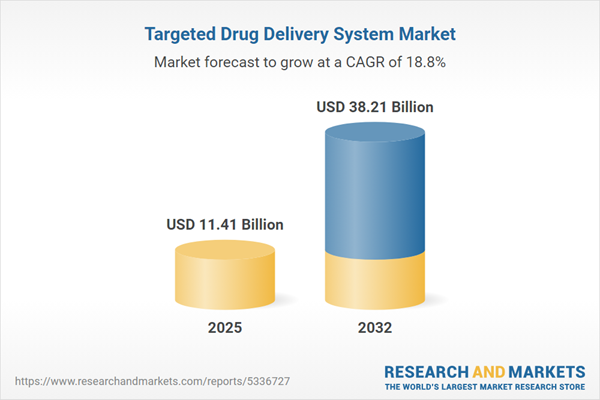Speak directly to the analyst to clarify any post sales queries you may have.
The targeted drug delivery system market is redefining precision medicine, providing senior executives in healthcare with the frameworks needed to align organizational goals to fast-evolving therapy models. These systems play a critical role in facilitating tailored treatments, addressing emerging operational needs, and supporting strategic advancements in care delivery.
Market Snapshot: Targeted Drug Delivery System Market
This market is progressing at a notable pace, supported by continuous developments in nanotechnology and rising capital flow from leading pharmaceutical and biotechnology organizations. Such movement fosters new clinical benchmarks, answering persistent demands for greater specificity and therapeutic effectiveness where traditional therapies may fall short. Hospitals and clinics continue integrating advanced delivery models and digital monitoring, resulting in enhanced patient adherence and greater personalization of care. The upward trend in adoption reflects the increasing role of targeted solutions in global healthcare, empowering providers to better meet both current and future dynamic care requirements.
Scope & Segmentation
This market research report delivers actionable segmentation to guide executive decision-making and reinforce operational stability in multiple care settings:
- Therapeutic Applications: Oncology, autoimmune, cardiovascular, orthopedic, and central nervous system disorders, allowing leaders to identify specific sector needs and develop targeted intervention strategies.
- Delivery Routes: Inhalation, intravenous, intraocular, local injection, oral, transdermal—permitting organizations to align delivery with clinical protocols and optimize patient outcomes across specialties.
- Technology Platforms: Liposomes, dendrimers, antibody drug conjugates, nanoparticles, microspheres—enabling precision in treatment and operational consistency while reducing off-target effects.
- Drug Types: Biologics, peptide-based drugs, nucleic acid therapies, small molecules—offering flexibility to respond to acute and long-term disease management requirements.
- End Users: Hospital networks, outpatient clinics, ambulatory surgical centers, research institutions—driving collaborative opportunities and raising standards of care through diverse partnerships.
- Sales Channels: Direct tenders, hospital pharmacy sales, digital platforms, retail outlets—supporting scalable distribution and facilitating access for various healthcare providers.
- Geographical Coverage: Americas, Europe, Middle East, Africa, Asia-Pacific, including insight into country-specific drivers in markets such as China, India, and Japan where regulatory and local demands influence market expansion and risk management.
- Company Profiles: Johnson & Johnson, F. Hoffmann-La Roche Ltd, Novartis AG, Pfizer Inc., Merck & Co., Inc., AstraZeneca PLC, Sanofi S.A., GSK plc, AbbVie Inc., Teva Pharmaceutical Industries Ltd. These organizations offer reference points for benchmarking and strategic assessment for executives.
Key Takeaways for Decision-Makers
- Targeted drug delivery systems empower leadership teams to adapt therapies in response to continually evolving care standards and organizational objectives.
- Strategic partnerships among pharmaceutical, biotechnology, and technology stakeholders facilitate more widespread adoption and efficient transfer of technical knowledge, especially in forecasted growth regions.
- Modern regulatory pathways streamline market entry, helping organizations embed crucial quality controls throughout production and supply chains while supporting broader trust across key networks.
- Developing resilient supply networks enables uninterrupted delivery even during unpredictable market events or changing trade conditions, stabilizing service to patients and partners alike.
- Deploying AI-based analytics and advanced clinical data tools supports more informed, agile decisions—forging leadership’s ability to successfully meet clinical and operational imperatives.
- Collaboration with patient advocacy groups enriches stakeholder engagement, smoothing the introduction and acceptance of emerging therapeutic solutions in diverse markets.
Tariff Impact: Shifting Global Supply Strategies
Recent shifts in U.S. tariffs are prompting organizations to explore nearshoring, elevate domestic production, and broaden supplier networks. These approaches are designed to maintain uninterrupted supply of targeted drug delivery systems, ensuring strategic continuity in the face of changing regulatory and trade conditions.
Methodology & Data Sources
The report’s findings are built on comprehensive reviews of peer-reviewed research, thorough analysis of global patent filings, evaluation of regulatory documents, and expert interviews in formulation and logistics. This approach ensures the highest accuracy and practical relevance for senior decision-makers in healthcare.
Why This Report Matters
- Equips executives to anticipate and address both investment opportunities and operational shifts driven by market and technology evolution.
- Enables adaptive leadership by clarifying regulatory procedures, streamlining clinical operations, and advancing continuous improvement initiatives throughout the organization.
- Highlights the pace of innovation, offering guidance to maintain organizational agility amid rapid therapeutic and operational changes.
Conclusion
With the targeted drug delivery system market shaping the next era of patient-focused care, organizations prioritizing innovation and partnership will drive sustainable value and performance as the sector continues to evolve.
Additional Product Information:
- Purchase of this report includes 1 year online access with quarterly updates.
- This report can be updated on request. Please contact our Customer Experience team using the Ask a Question widget on our website.
Table of Contents
3. Executive Summary
4. Market Overview
7. Cumulative Impact of Artificial Intelligence 2025
Companies Mentioned
The companies profiled in this Targeted Drug Delivery System market report include:- Johnson & Johnson
- F. Hoffmann-La Roche Ltd
- Novartis AG
- Pfizer Inc.
- Merck & Co., Inc.
- AstraZeneca PLC
- Sanofi S.A.
- GSK plc
- AbbVie Inc.
- Teva Pharmaceutical Industries Ltd.
Table Information
| Report Attribute | Details |
|---|---|
| No. of Pages | 186 |
| Published | October 2025 |
| Forecast Period | 2025 - 2032 |
| Estimated Market Value ( USD | $ 11.41 Billion |
| Forecasted Market Value ( USD | $ 38.21 Billion |
| Compound Annual Growth Rate | 18.8% |
| Regions Covered | Global |
| No. of Companies Mentioned | 11 |









